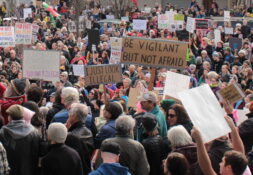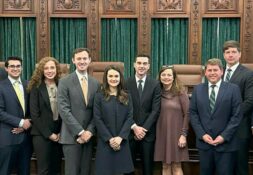Lecture addressed growing divide between “new upper class” and middle America
Political scientist Charles Murray gave a lecture on his work “Coming Apart: The State of White America, 1960-2010” to a full McKenna auditorium. The Constitutional Studies Program hosted the event as a complement to its gateway course, “Constitutionalism, Law, and Politics,” which is taught by Professor Phillip Muñoz and includes “Coming Apart” in its course readings.
Murray’s lecture focused on the relatively recent emergence of what he describes as the “new upper class,” or the “cognitive elite,” in the United States, which was driven by changes in college admissions and growth in the value of IQ in the market. He highlighted the way that colleges in 1950 became increasingly able to identify academic talent, leading to elite colleges with student bodies that were characterized by extremely high intelligence.
“The value of brains in the marketplace skyrocketed,” Murray claimed, explaining how people with very narrow cognitive talents have a much higher earning potential now than they would have had in the 1950s. He noted how the growth in the size of businesses has also allowed cognitively talented professionals like CEOs and lawyers to demand increasingly higher salaries.
These forces together have led to the greater geographical and social concentration of highly talented people. Members of the new elite tend to isolate themselves from mainstream America, leading to the creation of their own distinct culture.
“The combination of money and spatial concentration produced a new upper class culture. That new upper class culture has lots of characteristics,” Murray said.
Murray outlined some of the elements of the unique upper class culture, including so-called helicopter parenting, esoteric entertainment preferences, and a disdain for American mass-produced beer. Murray joked, “One of the hallmarks of the new upper class is that their disdain for Coors and Budweiser is palpable. If it’s not brewed by Belgian elves, they are not going to drink it.”
Murray described the new upper class culture as a bubble and created a quiz to help readers understand to what extent they are part of that culture. Questions include whether the taker has ever lived below the poverty line, walked on a factory floor, or had an Evangelical Christian friend. The most important question, Murray claimed, is whether one has had a job that causes a body part to ache at the end of the day. “If you have not,” Murray said, “It is really tough for you to empathize with people who have … you are really isolated from the common work experience.” He finds that increasingly the people with the “thickest bubbles” are often the people who mainly influence politics, finance, and media. He claims that the ignorance that many people in leadership positions have of the lives of average Americans contributes to the creation of bad policy, out-of-touch entertainment, and harmful financial practices.
Murray sees the election as a reflection of this new divide. He expressed his belief that working class Americans felt that the people in the power centers of the country have an open disdain for them and used Donald Trump as a “murder weapon” against the new upper class.
At the same time this change has occurred, there has been a deterioration in the living standards of the white working class. Murray noted a decrease in marriage rates and the workforce participation rate among working-age men, as well as an increase in opioid and alcohol abuse. He also discussed “the end of creedal America,” an America in which most citizens were committed to the values of egalitarianism, individualism, and freedom. Thus, he predicted that the growing economic, cultural, and social divide between the new upper class and the majority of Americans will eventually undermine American society and the American project.
Professor of Anthropology Agustin Fuentes offered a response to Murray’s talk. He first refuted Murray’s prior work regarding the connection between genetics and race. He also challenged several assumptions that undergirded Murray’s lecture, including the naturalness and widespread existence of the traditional nuclear family and the real cohesion around the concept of “creedal America” pre-1960.
Dan Conmy, a junior in Professor Muñoz’s class, reflected on the event to the Rover. “Despite Murray saying controversial things in the past, I thought his speech and book were an interesting look at the growing divide between the rich and poor in America,” Conmy said. “While I don’t know about his methodology or science, I think it’s important to understand the life of middle Americans and not live in a bubble.”
Mimi Teixeira is a junior studying political science and constitutional studies. She is also the proud owner of a Blackberry. You can contact her at mteixeir@nd.edu.






Leave a Reply